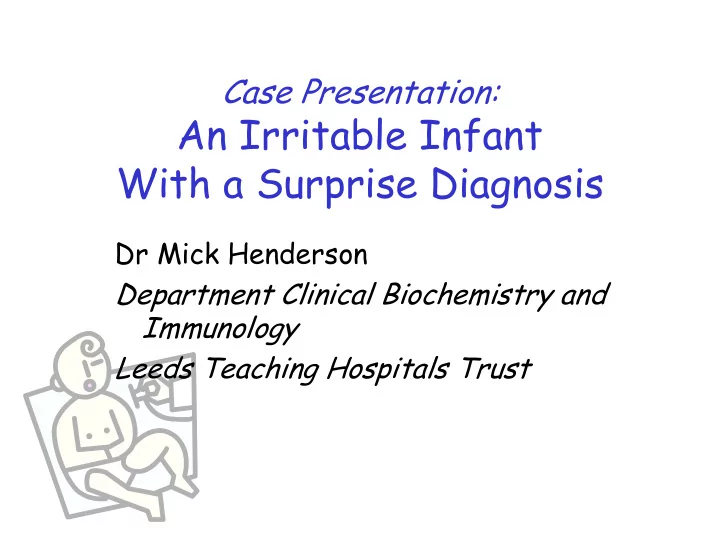

Case Presentation: An Irritable Infant With a Surprise Diagnosis Dr Mick Henderson Department Clinical Biochemistry and Immunology Leeds Teaching Hospitals Trust
Presentation • 2 year old female infant • Presented to local DGH with 2 month history of – vomiting – intermittent diarrhoea – lethargy and loss of appetite
Past Medical History • Normal term delivery weight 2.99 kg • Unrelated parents • two older healthy sibs • occasional episodes of profuse vomiting otherwise nothing of note
On Examination • Pale • Chest X-ray: NAD • Abdomen difficult to palpate due to tensing • Abdominal ultrasound reported as normal apart from loops of static bowel
Investigations • U&e, LFTs, unremarkable • FBC normal except for platelets, 583 (169-358) • Ammonia 22, lactate 1.4 • CRP 20.7 (0-8) • Urine culture: neg
Metabolic testing Samples sent for metabolic screening Due to unexplained vomiting • Plasma and urine amino acids: NAD • But……………
Urine Organic Acids Abundance TIC: 6801017.D 2000000 HMMA 1800000 1600000 1400000 1200000 HVA 1000000 800000 600000 400000 200000 10.00 15.00 20.00 25.00 30.00 35.00 40.00 45.00 50.00 Time--> Elevated HMMA and HVA, otherwise NAD
Catecholamine Metabolites Repeat samples requested for quantitation (preserved in acid) HVA; 86 umol/mmol creat (< 23) HMMA; 147 umol/mmol creat (< 14) Dopamine; 27.1 umol/mmol creat (< 1.75) Confirmation of elevated catecholamine excretion. Not consistent with an IEM, but pathognomonic of a tumour, neuroblastoma
Clinical Examination at Regional Centre • High resolution CT showed abdominal showed calcified mass on the midline, approx 9x9 cm encasing aorta and vena cava • Smaller sub-clavicular mass • No evidence of metastases, bone and lungs and clear by MIBG scan
Treatment and Prognosis • Parents understandably distressed at diagnosis but early detection should improve prognosis • Chemotherapy started within two weeks of initial evidence of diagnosis • Prognosis depend on n-myc status not yet determined
Neuroblastoma • arise from developing sympathetic nerve cells, neuroblasts • common solid childhood tumour • highly malignant • prognosis relates to age and stage at diagnosis • secrete catecholamines, predominantly dopamine and its metabolites
Catecholamine Metabolism phe tyr dopa dopamine 3 methoxy tyramine HVA nor adrenaline normetadrenaline HMMA adrenaline metadrenaline
Neuroblastoma can arise anywhere in the sympathetic nervous system. Primaries most commonly found in adrenal glands
Typical histological appearance of neuroblastoma Showing rosettes of neoplastic cells
Urine organic acids as an analytical tool • The intermediary metabolites of most metabolic pathways are small organic molecules, amenable to detection by ‘organic acid’ analysis • This is the most productive investigation in respect to detecting disturbances in metabolism, especially inborn • Will throw up surprises from time to time!
For more information or discussion about this case contact: mick.henderson@leedsth.nhs.uk
Recommend
More recommend